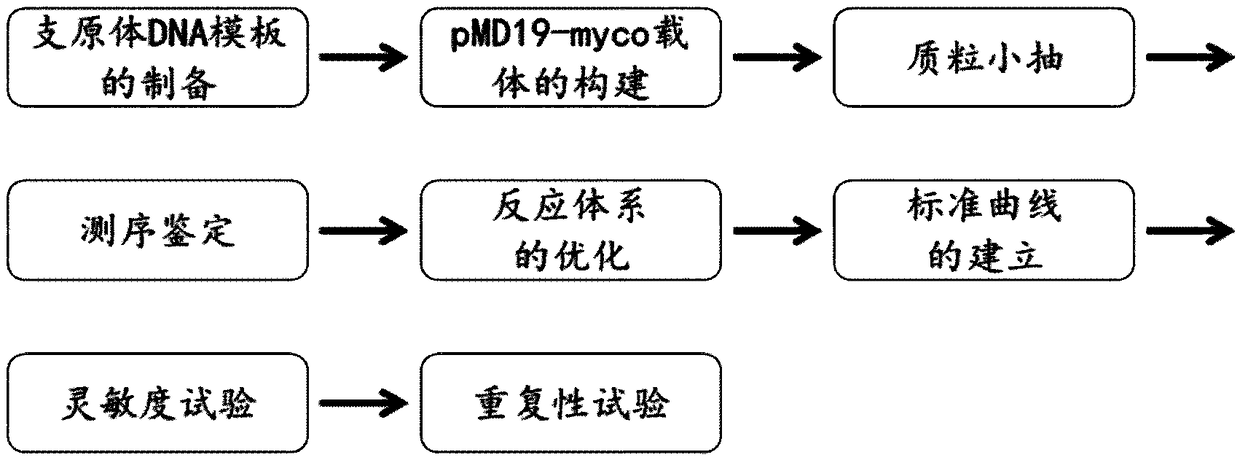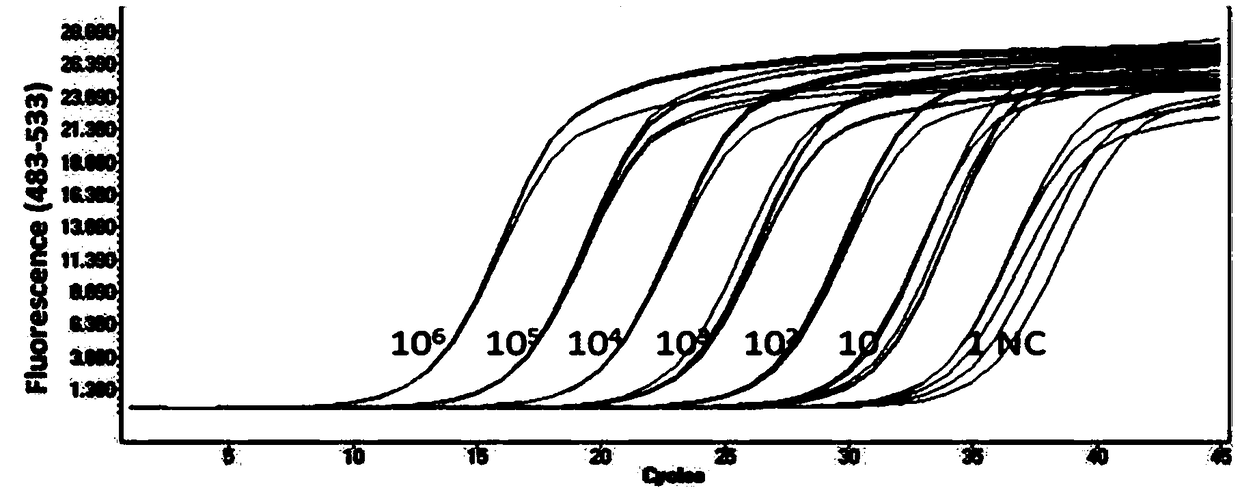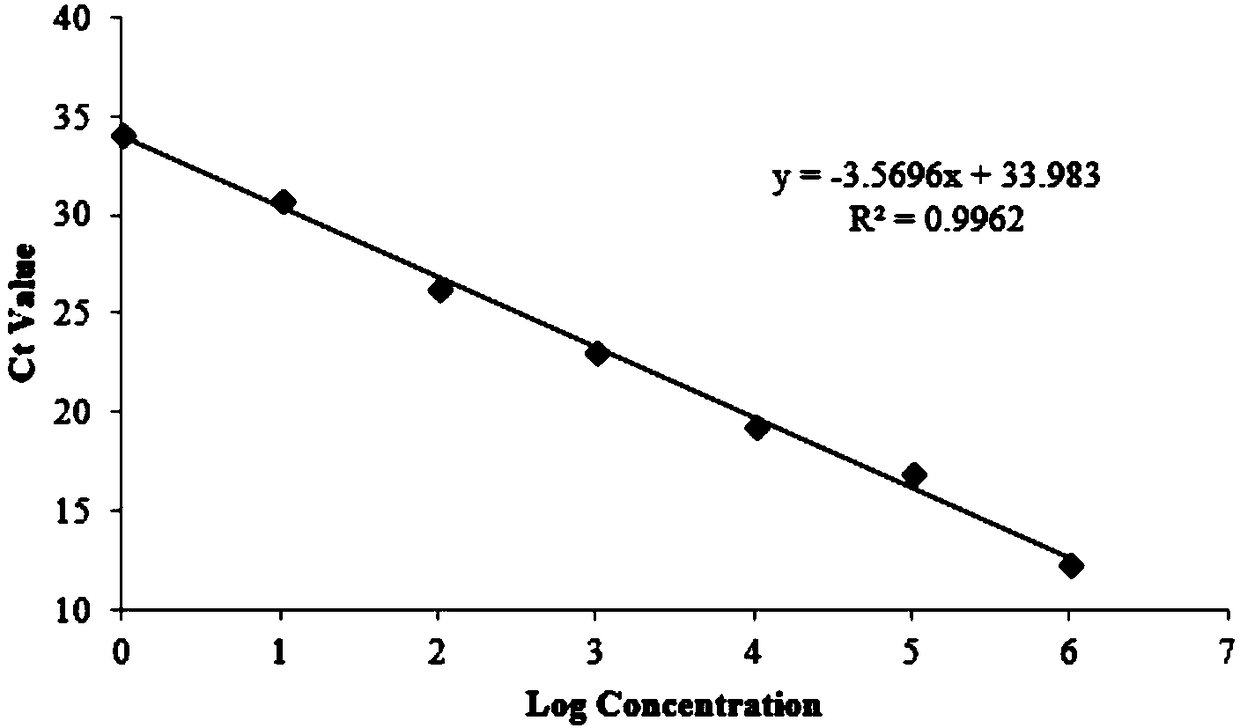Fluorescent quantitative PCR primer for detecting mycoplasma, detection method and application
A fluorescent quantitative and mycoplasma technology, applied in the field of pathogen detection, achieves the effect of good repeatability, high sensitivity, and rapid repeatability detection
- Summary
- Abstract
- Description
- Claims
- Application Information
AI Technical Summary
Problems solved by technology
Method used
Image
Examples
Embodiment 1
[0031] Design and synthesis of real-time fluorescent quantitative PCR primers for quantitative detection of mycoplasma in cell culture medium
[0032] (1) Primer design
[0033] Mycoplasma (M.orale), Mycoplasma fermentans (M.Fermentans), Mycoplasma arginini (M.arginini), Mycoplasma inflammatoryis (M. Arthritidis), Mycoplasma hyorhinis (M.hyorhinis) and A.laidlawii (A.laidlawii) 16S rRNA gene sequences were compared with DNA Man software, and according to the principle of fluorescent quantitative PCR primer design, Primerpremier5. 0, for the 16S rRNA gene of mycoplasma (this is the conserved region of mycoplasma), design upstream and downstream primers, primers are PAGE purification, and the described fluorescent quantitative PCR primer sequence that is used to detect mycoplasma is as follows:
[0034] Upstream primer: 5'-ACTCCTACGGGAGGCAGCAGTA-3' (as shown in SEQ NO.1)
[0035] Downstream primer: 5'-GATTACTAGCGATTCCGACTTCAT-3' (as shown in SEQ NO.2)
[0036] The synthesis o...
Embodiment 2
[0038] Real-time Fluorescent Quantitative PCR Detection of Mycoplasma in Cell Culture with Fluorescent Quantitative PCR Primers
[0039] figure 1 It is a technical roadmap of the real-time fluorescent quantitative PCR detection method for mycoplasma in cell culture solution of the present invention;
[0040] (1) Preparation of samples to be tested
[0041] a. Transfer 100 μL of cell culture medium to a 1.5 mL sterile EP tube, make sure that the EP tube cap is tightly sealed to prevent evaporation;
[0042] Adherent cells: After 2-3 days of cell culture, grow to a confluence of 80%-90%; Suspension cells: After 2-3 days of cell culture, the cell density reaches 5×10 5 -1×10 6 about;
[0043] b. Transfer 50 μL of cell culture solution to a sterile PCR tube, and heat-treat at 95°C for 5 minutes;
[0044] c. 12000rpm for 5s, take the supernatant and transfer it to a sterile PCR tube, and the sample can be detected immediately, or stored in a -20 degree refrigerator for frozen ...
Embodiment 3
[0060] Detection of mycoplasma samples in cell culture medium
[0061] Collect 10 samples of positive contamination of cell culture medium, and process the samples: transfer 100 μL of cell culture medium to a 1.5 mL sterile EP tube, and ensure that the cap of the EP tube is tightly sealed to prevent evaporation; take 50 ul of cell culture medium and transfer it to a sterile PCR tube Heat treatment at 95°C for 5min; 12000rpm for 5s, transfer the supernatant to a sterile PCR tube. Three replicate wells were set up for each group of samples, and a negative control (adding fresh medium, NTC) was set, and the real-time fluorescent quantitative PCR detection of mycoplasma in the cell culture medium was carried out with the reaction system and fluorescent quantitative PCR reaction conditions in step 3. The test results are: all 10 cell culture fluids are positive for mycoplasma contamination, and the CT value of the sample is substituted into the linear regression equation of the sta...
PUM
 Login to View More
Login to View More Abstract
Description
Claims
Application Information
 Login to View More
Login to View More - R&D
- Intellectual Property
- Life Sciences
- Materials
- Tech Scout
- Unparalleled Data Quality
- Higher Quality Content
- 60% Fewer Hallucinations
Browse by: Latest US Patents, China's latest patents, Technical Efficacy Thesaurus, Application Domain, Technology Topic, Popular Technical Reports.
© 2025 PatSnap. All rights reserved.Legal|Privacy policy|Modern Slavery Act Transparency Statement|Sitemap|About US| Contact US: help@patsnap.com



